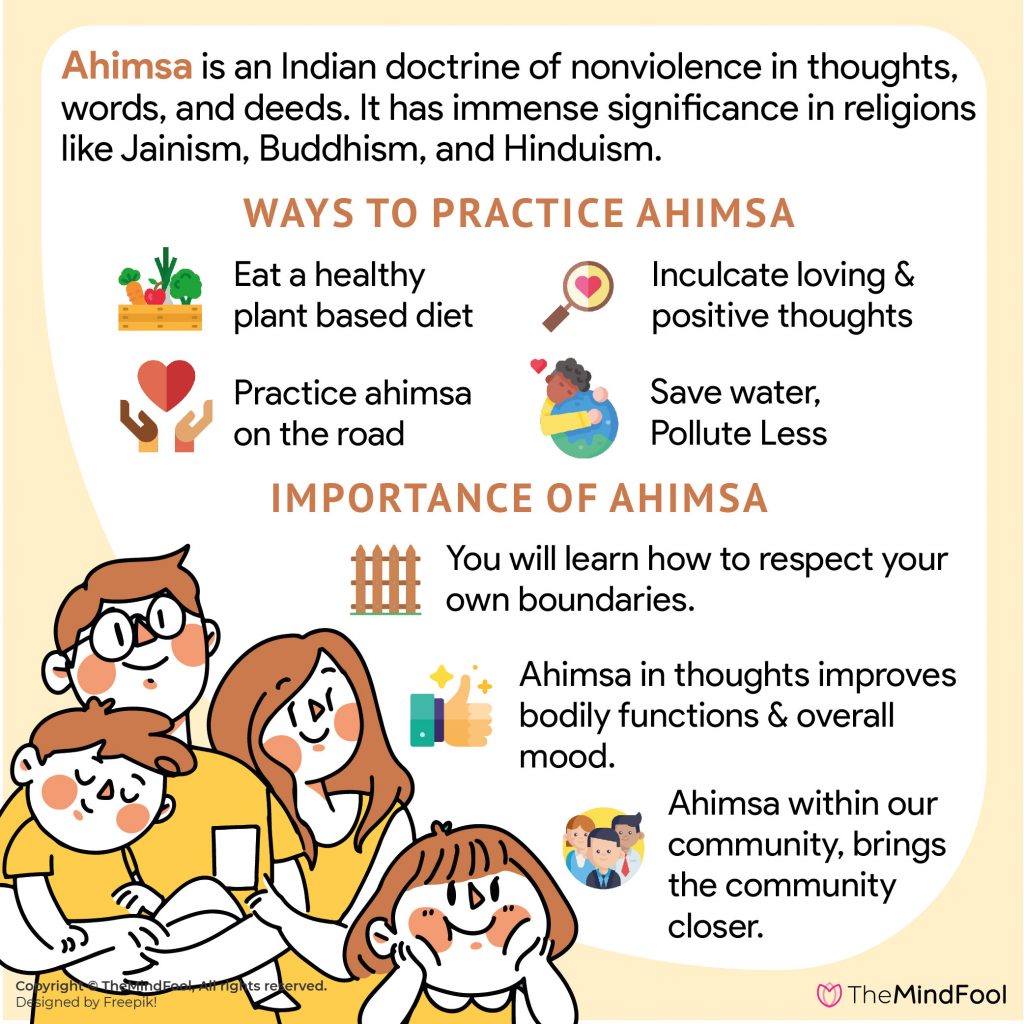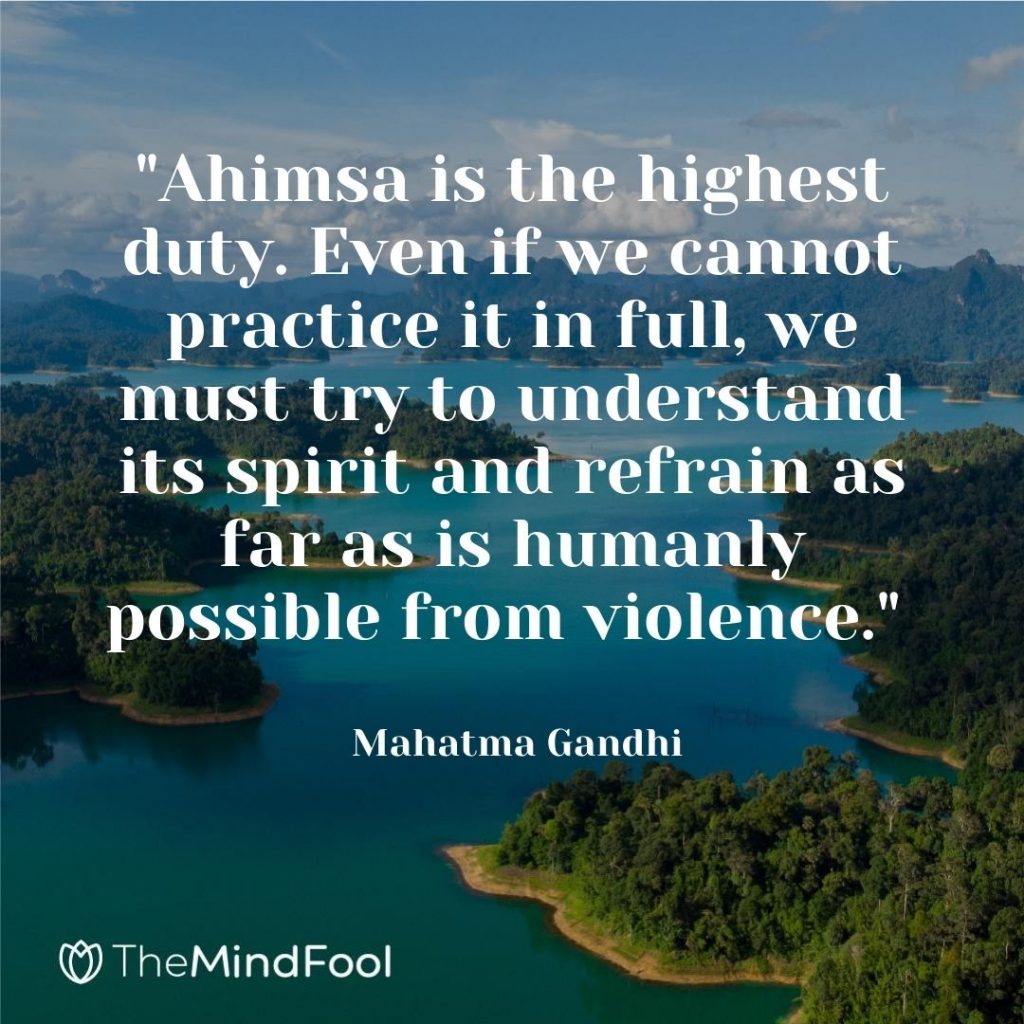
When we hear the word of Ahimsa, most of us think of Mahatma Gandhi or Martin Luther King Jr. Some of us may even think that it has nothing to do with us, as we do not participate in war and freedom struggles, and that we are normal citizens who do not engage in violence anyway.
While that is true, what we are not aware of is that the doctrine of Ahimsa has much deeper meanings than physical nonviolence. It extends to the violence in our thoughts, words, and deeds. Now, you must be wondering what that means, and how do you even commit violence in thoughts and words.
Find out the answer to all these questions, as well as the significance of nonviolence in our everyday life below.
Ahimsa Definition
SUMMARY
Ahimsa is an Indian doctrine of nonviolence in thoughts, words, and deeds. It has immense significance in religions like Jainism, Buddhism, and Hinduism.
Ahimsa is an ancient Indian principle of nonviolence with respect to all living beings. It is a Cardinal virtue of many Southeast Asian religions, like, Jainism, Hinduism, and Buddhism. The doctrine of ahimsa believes that all living creatures are sacred and as human beings, we should avoid harm and violence against any living creature.
It should be noted that ahimsa is always referred to as a practice, and not just a principle. Ahimsa is also often written as Ahimsa, and it comes from the Sanskrit root word Hins, which means to strike. Himsa refers to harm or injury, while Ahimsa is the opposite and it means the quality of non-harming or nonviolence. Literally translated, the word means ‘absence of injury’.
Hindu, Jain, and Buddhist texts all have the idea of reverence for the concept of nonviolence, but the origin of the quality may be traced back to the Vedas, nearly 4000 years ago. In the modern world too, the importance of Ahimsa has been emphasized by the 19th and 20th centuries’ spiritual figures like Shrimad Ramchandraji and Swami Vivekananda.

Ahimsa and Hinduism
It was first mentioned in the Vedic texts of Hinduism, but its importance was not emphasized. Slowly, the doctrine was refined, until it became one of the highest virtues of the religion.
Even in Mahabharata, one of the two epic poems in HInduism, Ahimsa sees its mention multiple times in the form of the phrase, ‘Ahimsa Paramo Dharma’ – which means nonviolence is the highest moral virtue of man. You can also see this phrase repeated in Bhagavad Gita, Adi Parva, and Vana Parva.
Despite teaching nonviolence as a doctrine to be followed by all human beings, Hinduism emphasizes that even people who practice Ahimsa must do what they have to when they are faced with war, violent threats, or when they need to sentence someone who is convicted of a crime.
What the appropriate response is in each of these instances, and how a proponent of Ahimsa should deal with them is discussed in various sacred texts like Arthashastra.
Ahimsa and Buddhism
According to Buddhism, Ahimsa is a part of the five precepts, and the first of them is to abstain from killing another being. It is applicable both for a Buddhist layperson, as well as the monks.
Buddhism does not punish himsa, but the devotees of the religion do believe in the karmic impact and the consequences of himsa in the life after rebirth. According to this belief, killing another being can lead to rebirth in a hellish realm. Therefore, the moral doctrine of Ahimsa is willingly self-enforced in Buddhist culture.
The religion not only recommends Ahimsa, but also suggests that one should avoid bartering items that are contributing to or are the result of violence:
“These five trades, O monks, should not be taken up by a lay follower: trading with weapons, trading in living beings, trading in meat, trading in intoxicants, trading in poison.”
— Anguttara Nikaya
Ahimsa and Jainism
Despite being a foundational principle of many Indian religions, it should be noted that no other religion has embraced the doctrine of Ahimsa in everyday life as Jainism has. There are several ways in which the principles of Ahimsa are practiced in Jainism:
- Killing of animals for food is completely unacceptable
- Steps are taken to ensure that there is no unnecessary violence against plants when it comes to making food for humans
- Jain monks and nuns make sure that they do not hurt even small insects and animals even as an accident
- Meat, fish, alcohol, and honey are rejected as they are derived by harming other life forms
- Potential injury to animals and other life forms is a deterrent to taking up any profession
For a regular Jain person, ahimsa is practiced with pramada, that is, violence is reduced by proper intention and taking care that every action in their daily life minimizes violence towards other beings.
Ahimsa Symbol
The Ahimsa Symbol is a hand with a wheel on the palm, and it symbolizes the vow for Ahimsa. In the center of the wheel, the word Ahimsa is written in Hindi.
The Wheel itself is representative of dharmachakra, which is a symbol of the Jain resolve to reduce the cycle of reincarnation of the human soul. This is achieved by pursuing the doctrines of truth and nonviolence on a relentless basis. This concept finds its basis in many Indian religions of which Ahimsa is also an integral part – like Jainism, Hinduism, and Buddhism.
You can also find this symbol quite often in Hindu and Buddhist temples, and inscriptions and statues, and it is now an important symbol in both of these religions.
Ahimsa Yoga
The practice of ahimsa is imperative for people who practice Patanali’s Raja Yoga Sutras, as it is the very first of the eight limbs and it is part of the five Yamas.
Yamas are practices of self-regulation and self-restraint, and they are designed in such a way that they help us prevent our own minds, bodies, and thoughts from becoming victims of base impulses. Yama practices are also believed to be cleaning techniques that help us cleanse our body, mind, and spirit.
In Yoga philosophy, Ahimsa, together with the second limb of Yoga, makes up the code of ethical conduct. It is also a precursor to asana, which implies that to be able to succeed in Yoga Asanas, one must purify themselves in every aspect – word, deed, and thought. This is done by practicing self-restraint of Ahimsa.
Sangeeta Vallabhan, a yoga teacher in New York City, emphasizes the importance of ahimsa in yoga by adding:
“Another way ahimsa is practiced in the yoga community is by becoming vegan or vegetarian. While having a mostly vegetarian diet is good, going completely meat- and dairy-free doesn’t work for every individual. A kinder option is to teach people to discern what is best for their bodies and their health. And… not shame people for their choices.”
Practicing Ahimsa
The use of the word practice with respect to ahimsa implies that it takes time, work and refining, to truly practice ahimsa. In theory, it seems quite straightforward to be able to practice Ahimsa. After all, we are all good citizens who do not go around hurting other people.
We all know that we should not all physical harm to anybody. However, there is more to Ahimsa than just the physical aspect of it. Inflicting injury on someone can also be due to your behavior, tone, words, or even your thoughts. All of these factors can turn into weapons that hurt other people if you do not use them wisely.
But before we understand this, we need to know what himsa means and how does himsa manifest in our everyday life.
The Meaning of ‘Himsa’
In the Vedas, himsa or injury can come from 3 methods –
- Kayaka, or injury by the hand, that is, the one that comes from physical actions
- Vacaka, or injury by expression, that is, the one that comes from words
- Manasika, or injury by the mind, that is, the one that comes from your thoughts
Technically, when you say harsh words to someone, you do not physical hurt them. But the injury from the harsh words, that is, vacaka, feels no different than physical pain. It leads to similar bodily reactions, like flushed cheeks after a slap in the face, nausea after a blow to the gut.
All of these reactions are the same as the reactions two physical injury, that is, kayaka. Moreover, it is obvious that after you say harsh words, the thoughts inside the person’s head to whom the words have been uttered are also extremely painful. This is the injury of the mind or the mansika violence.
Thus, it is clear that it is not possible to separate physical injury from word based or thought based injury.
How Does Himsa Manifest in Everyday Life?
Before we can Think of incorporating ahimsa in our everyday life, we first need to understand that our everyday actions and responses also contain elements of violence in subtle ways. Most of the time, we are not aware of these issues and they often also happen against our wishes.
Here are a few ways in which himsa manifests in our everyday life
1. Negative emotions
When our emotions are full of negative responses like guilt, resentment, disappointment, or when we feel ashamed or embarrassed, we are setting ourselves up for creating violence. If you cannot forgive someone for something they might have done against you, or if you can’t forgive yourself for a mistake, it sets you up for an act of violence.
2. Expectations
When you expect too much from yourself and start accepting the responsibility for the things that are out of your control, you are committing an act of violence against yourself. If it is impossible for you to achieve a certain target, yet you refuse to accept the reality and continue to torture yourself for things that are obviously not possible, it is an act of violence to the self.
The same goes for expectations from other people. You feel disappointment and anger when others cannot meet your expectations. This comes out as harsh words (vacaka).
3. Acting out of fear
When we act out of fear, the actions usually end up hurting people. For instance, if you are insecure about your position as a boss and are afraid that someone will find out, you will take it out on your employees, thinking it will make you look like a good boss in their eyes. When we are resentful of others for their success, it is a manifestation of our fear of not being as successful, and it comes out as harsh and jealous words.
All actions that stem from fear end up hurting not only the other person, but also our own self. Moreover, this is true for all actions of himsa. Often the person who is inflicting the pain suffers just as much as the recipient of the pain, both at the moment when they realize the significance of their actions, as well as later on.
Which brings me to my next point…
Why To Practice Ahimsa?
It is important to practice ahimsa in various aspects of our lives, from yoga to self healing, from community relationships to diet and inner thoughts. Let’s look at the benefits of ahimsa in each of these areas.
1. Benefits of Ahimsa in yoga
Whether you are a beginner, or an experienced Yogi, it is natural to feel frustrated when your yoga practice does not progress as quickly as you would like. Remembering ahimsa while you are practicing yoga can help you let go of negative thoughts about your body and accept yourself completely, irrespective of how strong or flexible we are feeling at the moment.
Non violence in yoga we don’t push ourselves too much, rather to challenge ourselves so that we can grow. Yoga, when combined with ahimsa, means only leaning in enough over the edge to grow, but never to the point of hurting yourself.
By doing this, you will learn how to respect your own boundaries and listen to your body. This makes yoga a more sustainable practice. You also learn how to practice self compassion and let go of the expectations of what you should be able to do. Removing negative thoughts of scolding yourself will help your body work with you, and not against you.
2. Benefits of ahimsa with respect to diet
Ahimsa in food refers to vegetarianism and veganism, which have proven to be immensely healthy. Not to mention the fact that you will also find more peace in knowing that your food does not cause the death of other animals, the research has also indicated that non-vegetarian diets are bad for the environment. Therefore, committing to a vegetarian diet will also prevent himsa against the earth.
To get the most out of this, you should keep a Journal where you monitor your energy levels, emotions, moods, and thoughts. Keep in mind that your body is a precious gift and you must honor it. By not having a proper diet, you are committing violence against your body. Treat your body like a temple and do not torture it with unhealthy and junk food.
You will start noticing the changes in your mood, energy level, and overall health pretty soon.
3. Benefits of ahimsa in thoughts
Our thoughts play an extremely important role in our overall well-being. Even if you are eating well, exercising a Lot, and taking in all the supplements you need, if your thoughts are harmful, you’re not going to feel very good.
Ahimsa in thoughts allows us to be mindful of what we’re thinking and deliberately choose loving thoughts over negative thoughts. This causes release of dopamine in the body, which is the feel good or relaxation hormone. It can strengthen the immune system, and even have the capacity to cure us from various types of diseases.
Research has indicated that nonviolent form of thinking or optimistic thinking improves immune systems, helps us recover from illnesses quickly, and can actually prolong our lives. And there is a bonus, ahimsa in our thoughts helps us feel happier, and research has shown that the happiness we experience is also contagious. Therefore, you will be spreading happiness to your friends and family as well.
In other words, ahimsa in thoughts improves bodily functions and also results in overall mood improvement for us as well as our near and dear ones.
4. Benefits of ahimsa with respect to self esteem and self respect
Ahimsa, when in relation to your self-respect, manifests as being kind towards yourself and accepting yourself with all your flaws. Letting go of your expectations from yourselves and allowing room for mistakes can result in An overall improvement in the quality of life, high self-esteem, attainment of inner peace, and a high probability of success in your personal and professional lives.
5. Benefits of Ahimsa with respect to the body
Ahimsa towards your body teaches you to prioritize your physical well-being as well. In other words, taking care of your body, exercising properly, taking care of your sleep hygiene, getting enough cardio and strength training all count as ahimsa towards the body.
Do not confuse this with ahimsa in diet. Both of these are equally important and have this synergistic effect on your overall health. Proper exercise and getting enough sleep releases good chemicals like dopamine and endorphins in your body. These hormones improve our immune system and keep us happy and healthy.
Moreover, it also decreases the levels of cortisol in our body. This is also known as the stress hormone and it weakens the immune system. It can also result in increased sensitivity to sickness and physical pain. Ahimsa works in the body in a way that it can help you in avoiding all these issues.
6. Benefits of ahimsa within the community
Practicing ahimsa within the community creates a feeling of equality and mutual respect. Each member of the community learns to manage their expectations about each other, and this helps prevent development of any kind of conflicts. Moreover, it also allows the whole community to follow proper guidelines and support each other. In difficult times, this can be the difference between Life and death.
In other words, practicing the doctrine of ahimsa within our community, whether it is just your family, or your office colleagues, or neighbors in a society, brings each member of the community closer to each other and benefits the entire group holistically.
7. Benefits are ahimsa with respect to humanity
The smallest of actions from a single human being can have far-reaching consequences. Because there is such a thing as the butterfly effect where a single butterfly can cause a hurricane far away when it flutters its wings. Every kind gesture that emerges out of ahimsa can strengthen Not only us and the society around us, but can also create an impact on a global level.
In other words, when we talk about practicing ahimsa at a personal level, we are inadvertently also promoting the doctrine within our community. And when Communities together start practicing ahimsa, it extends to the entire nation and then the entire world.
And when we practice ahimsa at the level of the entire world, it can solve the biggest of problems that the earth is facing right now. From global warming and ozone depletion to hunger, war, riots, drug problems, and everything else that is wrong in the world, we can be solve it with ahimsa.
10 Ways To Practice Ahimsa
Before you take a deep dive and try to understand how to practice ahimsa, know that and this is a practice that will take time to manifest itself and its effects. Do not expect any drastic changes within a few days. Strong intentions and patience are the key here.
1. Eat a healthy plant-based diet
You don’t have to make a life altering change by tomorrow, but what you can do is slowly transition into a healthier diet that does not harm other beings. You can start with a one-week diet plan Which includes only healthy vegetarian foods. A lot of people ask if they have to be vegetarian or vegan To practice ahimsa completely. The doctrine of ahimsa states that we should not harm another living being, therefore, it would make sense to abstain from eating meat.
However, there has to be some balance. If cutting out certain food items from your diet causes harm to your mind, body, and mood, then you should re-evaluate and consider what works best for you as well as the world around you. If you cannot stop eating meat, and then you can change things a little bit and support companies that are environmentally friendly.
You can try to eat more organic food items, and practice veganism or vegetarianism a couple of days in a week or month. But whatever you choose to do, it is important to consider both the environment as well as your own well being at the same time. Moreover, you should also try to avoid excessive consumption of alcohol, drugs call mom coffee, smoking, food that is too spicy, and bad eating habits like eating in a hurry, eating while watching TV, etc.
All of these habits count as himsa against your own self.
2. Inculcate loving and positive thoughts
Your mind is a powerful tool, and it plays an important role in Everything that you do, including cultivating the doctrine of ahimsa in your life. There are certain Weeds in your mind that you need to take out, like negativity, self criticism, self harm etc.
This is because himsa the level of thoughts translated into actions and words. If you are always critical towards yourself, you will end up being critical of others and hurting them. If the torch inside your mind is negative, you will not be behaving positively with others. Therefore you need to accept and appreciate the beauty, wholeness, and imperfect perfectness of your own self, along with the same in other people.
Here are some habits you can inculcate to root out this inner himsa:
- Practice radical self-acceptance
- Be kind to yourself
- Give genuine compliments to other people
- Learn how to control your anger
- Be empathetic and perform random acts of kindness
- Practice gratitude on a daily basis
All these activities then strengthen the roots of ahimsa in our mind.
3. Do not skip meals and practice adequate sleep hygiene
Have you ever noticed that when you are hungry, sleepy, bored, or tired, you tend to be more impatient, grumpy, short tempered, and out of balance. This indicates that your prana or vital energy is low. And when that happens, it is extremely difficult to be compassionate and practice ahimsa.
Therefore, it is important to maintain high prana levels. You can do this by having meals at the right time and practicing adequate sleep hygiene. If this is something that you struggle with, you can also come from various apps available online that can help you monitor your sleep and eating habits.
4. Practice ahimsa on the road
When you are in The car, and if someone cuts you off aggressively, is natural to feel a sudden burst of anger. You may even be tempted to drive even more aggressively, or say something hurtful. However, both of these actions will only end up hurting your own mental peace and disturbing your mood for the rest of the day.
Therefore, it is necessary to practice ahimsa on the road as well. This of course will need some training, time, effort, and energy. Do not expect yourself to attain this goal quickly, give yourself time to make slow and consistent changes over a long period of time.
5. Ahimsa towards mother earth and its ecosystem
Try to live every single day in an environmentally friendly way, so that you can practice ahimsa towards mother earth as well. Here are some examples for doing this:
- Prefer staircases instead of elevators save electricity and also to give yourself short bursts of cardio
- Instead of using a car, try walking and riding bikes. You can also use carpool options whenever it is possible.
- When you go grocery shopping, bring your own bag from home instead of getting plastic bags
- Instead of shopping at big brands, try to support local businesses, farmer markets, and produce shops
- Switch to organic and natural products instead of ones that use harmful chemicals
- Try to plant at least one tree every year
- Minimize the use of paper products and prefer using recyclable containers
- Compost food scraps, vegetable peels, and fruit waste
- If you eat eggs, buy from cage free hands. Similarly, buy milk from grass fed cows that do not have any synthetic hormones
- Try reducing meat consumption In your diet
- When it comes to shopping for clothes and cosmetics, start that you buy from ethical companies
6. Practice Yoga… Compassionately
If you practice yoga, there must have been moments where it is difficult to concentrate and do what needs to be done. As a result, you might get frustrated and angry with yourself. Ahimsa in Yoga means being gentle with yourself.
Here is how you can incorporate ahimsa into the path of yoga:
- Learn to do sadhana, that is, practice, in a disciplined way, without letting your mood affect it
- Avoid harming your sadhana by either being too pushy with yourself or being too lazy
- When your body demands rest, oblige
- Pay attention to your breath constantly
- If you are practicing in a studio or class, do not pay attention to other students, and do not compare yourself with them
- Do not base your self-worth on whether or not you can do a particular asana or not
- When you are doing certain asanas, do not have any unkind thoughts for your body. Stop worrying about whether or not your body looks good in a particular asana or not, or whether someone is noticing your love handles when you do a side bend
- If your mind does not stay calm during savasana and meditation, do not get frustrated with yourself
These are simple ways to ensure that you are not committing himsa against yourself when you practice yoga.
7. Let things go
Often, we cling to the past, or we have an obsessive need to control everything. This gives rise to frustration, pain, and other negative emotions. In fact, the compulsive need to maintain control of our surroundings also emerges out of fear, and can very easily slip into aggression, violence, and other forms of himsa.
Try to find inner peace by observing your thoughts and letting go of anything that is holding you back from having a happy and peaceful life.
8. Learn how to resolve conflicts peacefully
No matter where you are or what kind of a relationship it is, conflicts will happen – in work, in relationships, with neighbors, communities, and even between countries.
Whenever there is a conflict, there are two sides to it. And no matter who starts it, eventually, both parties are wounded. Conflicts arise because both parties tend to stick to what they believe in, but to resolve the problem, both of them need to overcome their ego and look at the bigger picture. The primary reason for conflict is, and it does not matter what kind of conflict it is, the breakdown of communication. Thus, it is natural that negotiation and dialogue in a peaceful way is extremely important for resolving conflicts.
Here are some ways in which you can use the doctrine of ahimsa to resolve conflicts peacefully:
- Keep in mind that everyone is fighting their own battles, and everyone is looking for love. This will help you remember that the problem is the conflict, not the other person.
- Nourish your spirit with love. Whenever you hear that little voice in your head that speaks negatively about others, remember to silence and replace this voice with something kind.
- Hatred and violence come naturally to the human mind. Make a conscious decision to practice ahimsa in every single task during the day and learn how to feel these negative emotions without judgment or needing to act on them.
- Try to incorporate the core values of Ahimsa, such as gentleness, understanding, love, patience, and compassion with everyone and everything. In a difficult situation, try to give the other person the benefit of doubt.
9. Strive for inner peace
When your life is going well, it might seem easy to practice ahimsa. But it is only when stress and fear start making their presence known that it becomes extremely difficult to keep our best intentions. As emotional creatures, it is not a surprise that we react to instability with violent thoughts like frustration, anger, resentment, and other negative feelings.
However, to maintain calm in our everyday environment despite the presence of negative stressors, we must learn to maintain inner peace. This article features a variety of ways of doing this.
10. Donate to nonviolent initiatives
There are many initiatives and charities that work towards nonviolence and peace all over the world. If you cannot participate and contribute yourself, you can support these organizations. It will make a global impact and strengthen the doctrine of ahimsa all over the world.
Ahimsa Quotes
“Ahimsa is the highest duty. Even if we cannot practice it in full, we must try to understand its spirit and refrain as far as is humanly possible from violence.”
~ Mahatma Gandhi

“Never producing pain by thought, word, and deed, in any living being, is what is called Ahimsâ, non-injury.”
~ Swami Vivekananda

“The power of unarmed nonviolence is any day far superior to that of armed force.”
~ Mahatma Gandhi

“Until we stop harming all other living beings, we are still savages.”
~ Thomas Jefferson

“Non-violence leads to the highest ethics, which is the goal of all evolution. Until we stop harming all other living beings, we are still savages.”
~ Thomas A. Edison

Ahimsa Tattoo
Here are some of the sample designs of Ahimsa Tattoo –
On Parting Thoughts
When practicing ahimsa, remember the story of the sage who told the bruised snake whom he had told to practice ahimsa. He said to the snake, “I told you not to bite, but I didn’t say you cannot hiss.”
Being kind to other people does not mean that you should let them abuse you. Use your mental and emotional faculties to determine when it is valid to practice ahimsa, and when you should show some firmness to avoid being taken advantage of. Take care of your own needs first, and find ways to be happy, healthy, and calm. Ensure your own place of calm and compassion is not threatened when practicing ahimsa.
Surabhi has a deep passion for words. She puts her heart and mind into whatever she pursues and craves for creative ventures. She has always been keen on creating original content that can make a difference. In her experience as a content writer, she has had the opportunity to work on several fields with Psychology being her favorite. Surabhi says, words have the power to transform the world, better than a sword. So she hopes to contribute her bit to this revolution. At TheMindFool, she feels lucky to have the opportunity to share content capable of bringing about a change in the lives of the readers.
